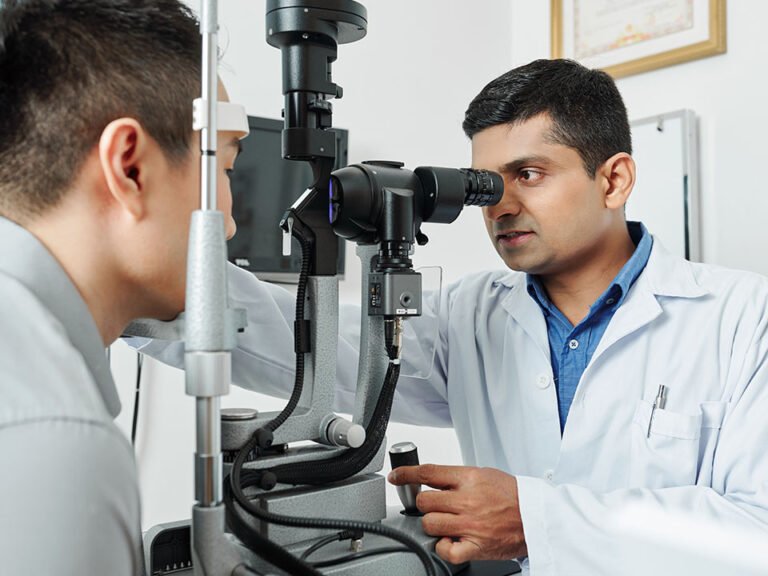Eye Changes When You Come Down With Diabetes
Changes in vision may happen at the time that diabetes is first diagnosed or at any time that blood sugar control is poor. Fluctuating blood sugars cause the lens to swell and shrink, and result in fluctuating vision. Many times, people who have borderline diabetes finally decide to take their diabetes seriously when their vision becomes blurred.
Sometimes, people coming down with diabetes marvel that they no longer need their glasses to see in the distance. But as insulin or other therapy is begun and the blood sugar drops, the abnormal swelling diminishes. In the short-term vision becomes blurred and is not corrected by their prescription lenses. Either of these scenarios can be frightening to people who have heard of the severe eye damage that goes along with diabetes.
Blurred vision in both eyes when insulin or other treatment begins is almost never caused by damage to the eye. Rather, it results from the speed at which the swelling, due to high blood sugars in the previous weeks and months, dissipates from the lens. Vision is usually out of sync for 3 to 4 weeks, sometimes with an accompanying headache.
Do I Need To Follow Up With My Doctor After Being Diagnosed With Diabetic Eye Disease
If you or someone you know has diabetes and mild diabetic eye disease, follow-up examinations with an ophthalmologist every year may be all that is necessary.
If the person has a more serious disease, more frequent follow-up appointments with an ophthalmologist are required based on the severity of the disease.
How Are These Eye Conditions Treated
Unfortunately, once you develop any of these diabetes-related eye problems, they cannot be reversed. Doctors can only try to prevent them from getting worse. Many times, they require surgery.
Treating cataracts depends on how bad they are. If your cataracts arent bothering you much, you can ease symptoms by having your eyeglass prescription adjusted. When your cataracts begin to prevent you from performing your normal activities, they can be surgically removed.
Diabetic retinopathy, glaucoma, and macular edema are a bit more difficult to manage. Eye drops are used to help keep the pressure and swelling to a minimum, but one of the following may also need to be done:
-
. This is a type of laser surgery to help treat retina problems and macular edema. It involves sealing the blood vessels around your retina that are most likely to start leaking.
-
Vitrectomy. If the blood vessels in your retina are leaking a lot of fluid, your doctor may recommend this procedure to remove blood from inside your eye as well as any scar tissue on your retina.
-
Injectable eye medications. These are an option for those with glaucoma or macular edema. There are a few injectable medications for glaucoma , and they stop your eye from making new blood vessels that can leak more fluid into your eye and increase eye pressure. For macular edema, injectable medications include steroids and anti-inflammatories that help reduce and control swelling.
Also Check: Which Is Worse Type I Or Ii Diabetes
How Diabetic Retinopathy Is Diagnosed
During your eye exam, your eye doctor will check how well you see the details of letters or symbols from a distance. Your doctor will also look at the retina and inside of your eyes and may use a dye to reveal leaky blood vessels. If it turns out you have diabetic retinopathy, your eye doctor may want to check your vision more often than once a year.
You should be checked for diabetic retinopathy immediately if youre diagnosed with type 2 diabetes. If you have type 1 diabetes, you should be checked within 5 years of your diagnosis and then regularly thereafter, typically every year. The sooner youre treated for diabetic retinopathy, the better that treatment will work.
- Blurring
- Difficulty reading or doing detail work
Related Diabetic Eye Diseases

Glaucoma and cataracts are also considered diabetic eye diseases.
- Glaucoma risk is nearly double in diabetics. Aside from blurry vision, symptoms also include loss of vision, halos around lights, eye pain, red eyes, and vomiting.
- Cataracts tend to develop earlier in diabetics, and the risk is two to five times higher. Blurry vision, faded vision, double vision, halos, and sensitivity to light are all symptoms.
The good news is that early detection and treatment reduces your risk of going blind by a whopping 95%.
You May Like: Diabetes Test App For Android
Which Specialties Of Doctors Treat Diabetic Eye Disease
Ophthalmology is the specialty of medicine that deals with the diagnosis and treatment of eye disease. The ophthalmologist is the appropriate person to both diagnose and treat diabetic eye disease.
Some ophthalmologists limit their practice to diseases of the retina. A general ophthalmologist can decide whether or not the specific patient requires an evaluation by a subspecialist in retinal disease.
People with diabetes also will be cared for by their family doctor or internal medicine specialist and other subspecialists as needed.
How To Reverse Type 2 Diabetes
No person on this earth would be happy if their lives go hula hooping around medicines and tablets. And diabetes is the disease that goes on to grow, leading to several other life-risking diseases.
However, completely curing type 2 diabetes is impossible. But there have occurred a few ways, availing which you might reverse your diabetes to an extent. The only way to do that is to control your glucose and keep a count of the sugar and carbs you consume all through the day. Here are a few healthy steps that will contribute to your effort in maintaining the blood sugar level in your body:
Don’t Miss: How To Take Care Of Your Feet With Diabetes
Complications Of Untreated Cataracts
Cataracts will worsen over time, so your vision will too, making it difficult to do daily tasks. When left untreated for a long time, cataracts can cause total blindness. The World Health Organization reports that cataracts are the number one cause of blindness worldwide. Ultimately, cataracts can progress at different rates, which makes postponing surgery dangerous. When your eyes are not properly cared for or are exposed to smoke, radiation, or UV rays, your cataract can progress faster.
Can Diabetic Retinopathy Be Prevented Or Avoided
The best way to prevent diabetic retinopathy is to work with your doctor to manage your diabetes. You should also have your eyes checked regularlyat least once a year. Your doctor can tell you if you should have them checked more often.
Tips for preventing diabetic retinopathy:
- Control your blood sugar, blood pressure, and cholesterol
- See your family doctor regularly.
Don’t Miss: Best Type 2 Diabetes App
What Does Diabetes Blurry Vision Look Like
One of the widespread indicators of diabetes mellitus is blurred imaginative and prescient, which refers back to the lack of sharpness of imaginative and prescient and the lack to see superb particulars. Blurred imaginative and prescient can have an effect on one eye or each eyes, and may happen typically or hardly ever.
The Safest Most Effective Option Is Cataract Surgery
While cataract surgery may sound scary, its actually the safest, most effective option for the removal of cataracts and restoration of your vision. At Florida Eye Center, a board-certified eye specialist in Tampa will perform state-of-the-art phacoemulsification in which the cataract is removed and an artificial lens is implanted through a single small incision. The entire surgical procedure is performed in approximately fifteen minutes in an outpatient setting. The process is virtually painless, and even patients in their eighties and early nineties can undergo this surgery without fear of complications.
The benefits are immeasurable. When you receive cataract treatment in Tampa with Florida Eye Center, you will be provided with the latest advanced technology lenses, such as the AcrySof® ReSTOR® or AcrySof® Toric Intraocular Lens . Newer lenses, such as the ReSTOR® lens, have been uniquely designed to improve vision at all distances, allowing you to live free of glasses for most activities. For any questions about cataract surgery or to simply schedule a routine eye examination, contact us today.
Recommended Reading: Can You Reverse Blindness From Diabetes
How Does Diabetes Affect Your Eyes
Diabetes can lead to blurry vision in several ways.
In some cases, its a minor problem that you can resolve by stabilizing your blood sugar or taking eye drops. Other times, its a sign of something more serious thats worth discussing with your doctor.
In fact, blurred sight is often one of the first warning signs of diabetes.
Precautions For Reducing The Risk Of Diabetic Retinopathy

Reduce the risk of developing diabetic retinopathy, or you can also help stop this condition from getting worse, by maintaining the blood sugar levels, blood pressure and cholesterol levels at optimal levels. In order to avoid Diabetic Retinopathy make the choice of a healthy lifestyle like eating balanced meals, regular exercise, avoiding smoking etc.
Do not miss your regular eye-examinations as many eye complications can be detected early through such screening and vision loss can be prevented. With treatment diabetic retinopathy can be reversed to an extent. But the best thing is to prevent it with early diagnosis.
Also Check: How To Lower High Blood Sugar Without Insulin
What Other Problems Can Diabetic Retinopathy Cause
Diabetic retinopathy can lead to other serious eye conditions:
- Diabetic macular edema . Over time, about 1 in 15 people with diabetes will develop DME. DME happens when blood vessels in the retina leak fluid into the macula . This causes blurry vision.
- Neovascular glaucoma. Diabetic retinopathy can cause abnormal blood vessels to grow out of the retina and block fluid from draining out of the eye. This causes a type of glaucoma .
How Is Retinopathy Treated
Huge strides have been made in the treatment of diabetic retinopathy. Treatments such as scatter photocoagulation, focal photocoagulation, and vitrectomy prevent blindness in most people. The sooner retinopathy is diagnosed, the more likely these treatments will be successful. The best results occur when sight is still normal.
In , the eye care professional makes tiny burns on the retina with a special laser. These burns seal the blood vessels and stop them from growing and leaking.
In scatter photocoagulation , the eye care professional makes hundreds of burns in a polka-dot pattern on two or more occasions. Scatter photocoagulation reduces the risk of blindness from vitreous hemorrhage or detachment of the retina, but it only works before bleeding or detachment has progressed very far. This treatment is also used for some kinds of glaucoma.
Side effects of scatter photocoagulation are usually minor. They include several days of blurred vision after each treatment and possible loss of side vision.
In focal photocoagulation, the eye care professional aims the laser precisely at leaking blood vessels in the macula. This procedure does not cure blurry vision caused by macular edema, but it does keep it from getting worse.
There are two types of treatment for macular edema: focal laser therapy that slows the leakage of fluid, and medications that can be injected into the eye that slow the growth of new blood vessels and reduce the leakage of fluid into the macula.
You May Like: What Is The Best Sweetener For Type 2 Diabetes
When To See A Doctor For Diabetic Eye Disease
Even if the person is not experiencing any symptoms due to diabetes, the person should have an annual eye examination by an ophthalmologist . If the ophthalmologist notices any significant signs of diabetic eye disease or if the person requires treatment, exams may need to be scheduled more frequently than annually.
If the person notes any significant changes in vision other than a mild temporary blurring, they should contact an ophthalmologist immediately.
Questions to ask the doctor about diabetes and eye problems
- Are there any signs of permanent damage to my eyes from diabetes?
- Is there any significant loss of vision? If so, is this loss of vision permanent?
- Are there any signs of cataracts or glaucoma?
- Do I need any treatment at this time for any problems with my eyes?
- How often do I need to be examined?
How Does Diabetes Cause Blurry Vision
Diabetes and the subsequent high blood sugars can cause blurry vision in several ways:
You May Like: How Much Sugar Diabetes Type 2
Can Dr Be Treated/reversed
Fortunately, diabetic retinopathy is preventable and also treatable. Maintaining blood sugar at an optimal level can help to prevent this serious condition. As controlled diabetes can also lead to diabetic retinopathy, it is advised to have your eyes examined regularly. This way, your ophthalmologist can diagnose and treat any retinal damage as early as possible. Also, reversing diabetic retinopathy is very much possible when this vision-threatening condition is detected in the early stages.
When To See A Doctor
A range of medical conditions can cause blurry vision, and diabetes is just one.
Most people who start to have blurry vision simply need eyesight correction with the help of an optometrist.
However, anyone who develops blurry visionwhether or not they have diabetesshould see a doctor, especially if:
- a problem appears suddenly
- the problem gets worse
Eye problems can stem from new cases of diabetes or a complication of an existing condition.
Anyone who already has a diabetes diagnosis should go for a routine eye examination at least once a year. Regular tests can detect any problems while they are still minor.
Recommended Reading: Weight Loss Supplements For Diabetics
S For Diabetic Eye Care
In general, keeping near-normal blood glucose and eating right seem crucial to eye care. Writing in Diabetes Self-Management, Linnea Hagberg, RD, suggestsconsuming leafy green vegetables like spinach, kale, collards, and broccoli.
Hagberg also recommends corn, kiwifruit, red grapes, spinach, zucchini, yellow squash, orange peppers, orange juice, egg yolks, and Vitamin E as being good prevention for AMD and cataracts. For general diabetes eye health, she says:
Wear sunglasses that protect the eyes from ultraviolet rays.
Keep blood glucose under control.
Stop smoking or cut back as much as possible.
Choose brightly and deeply colored fruits and vegetables as often as possible. Include leafy green vegetables in your meals several times a week.
Include plenty of vitamin C in your diet by choosing several daily servings of foods such as cantaloupe, strawberries, citrus fruits, kiwifruit, mango, papaya, broccoli, Brussels sprouts, sweet peppers, tomatoes, and cauliflower.
Eat fatty fish two or three times a week. Limit total fat and commercially processed baked goods and snack foods.
Have an annual eye exam that includes dilating the pupils.
Have you experienced visual changes at different glucose levels? Id be interested in hearing about it.
Want to learn more about keeping your eyes healthy with diabetes? Read Eating for Better Vision and Healthy Eyes and Keeping Your Eyes Healthy and Protect Your Eyes From Diabetes and watch Diabetes and Your Eyes.
Can Type 2 Diabetes Be Reversed

Type 2 diabetes can be a life-long, chronic disease in which the body either does not produce enough insulin or the cells in out body doesnt respond to insulin correctly. Because of these two problems, there isnt enough insulin to move the glucose from the blood into the cells. When glucose builds up in the blood instead of going into cells, the bodys cells cant function properly.
Type 2 diabetes is more likely to occur in people who are over the age of 40, overweight, or have a family history in diabetes. Certain ethnic and racial groups also have higher risk for type 2 diabetes, including black, Hispanic/Latino, American Indian, Asian American and Pacific Islander. However, over the past decade the incidence of type2 diabetes has been increasing in adolescents and the young adult population.
According to recent research, type 2 diabetes cannot be cured, but individuals can have glucose levels that return to non-diabetes range, or pre-diabetes glucose level The primary means by which people with type 2 diabetes achieve remission is by losing significant amounts of weight.
We talk of remission and not a cure because it isnt permanent. The beta cells have been damaged and the underlying genetic factors contributing to the persons susceptibility to diabetes remain intact. Over time the disease process reasserts itself and continued destruction of the beta cells ensues. An environmental insult such as weight gain can bring back the symptomatic glucose intolerance.
You May Like: Medtronic Closed Loop Insulin Pump
Diabetes And Blurred Vision
Don’t run out and buy a new pair of glasses as soon as you notice you have blurred vision. It could just be a temporary problem that develops rapidly and is caused by high blood sugar levels.
High blood sugar causes the lens of the eye to swell, which changes your ability to see. To correct this kind of blurred vision, you need to get your blood sugar back into the target range. For many people this is from70 mg/dL to 130 mg/dL before meals and less than 180 mg/dL one to two hours after the start of a meal. Ask your doctor what your personal target range should be.
Blurred vision can also be a symptom of more serious eye problems. If your vision is blurred, contact your doctor right away.
The American Diabetes Association offers these eye care guidelines for people with diabetes:
- Adults with type 1 diabetes should have a full dilated eye exam within 5 years of their diagnosis.
- Adults with type 2 diabetes should have a complete eye exam soon after they have been diagnosed.
- Get a dilated eye exam if you are pregnant or planning to get pregnant.
Show Sources